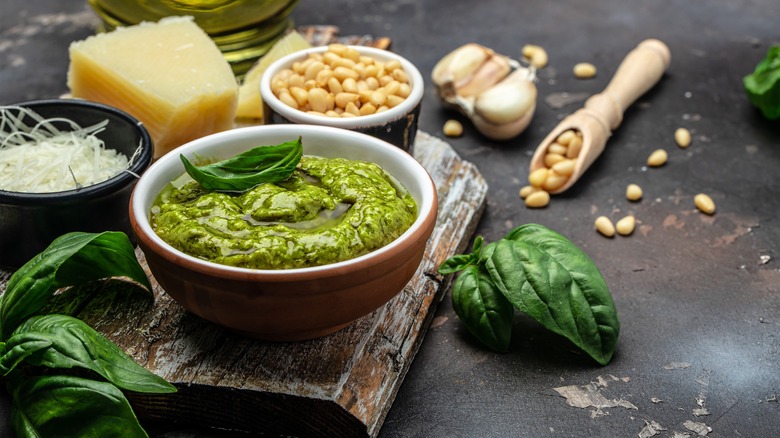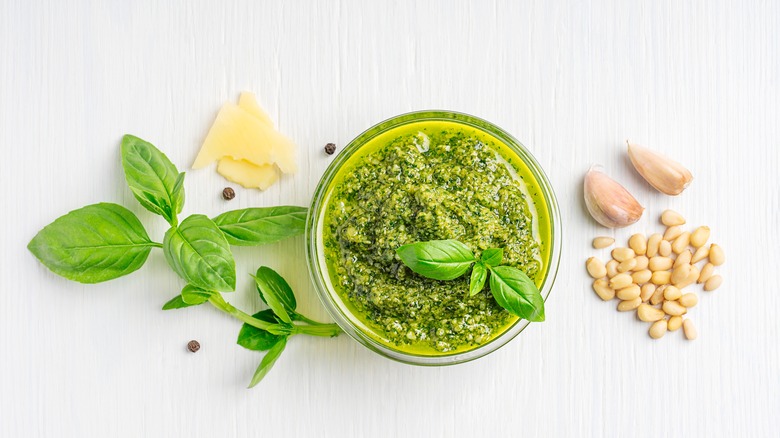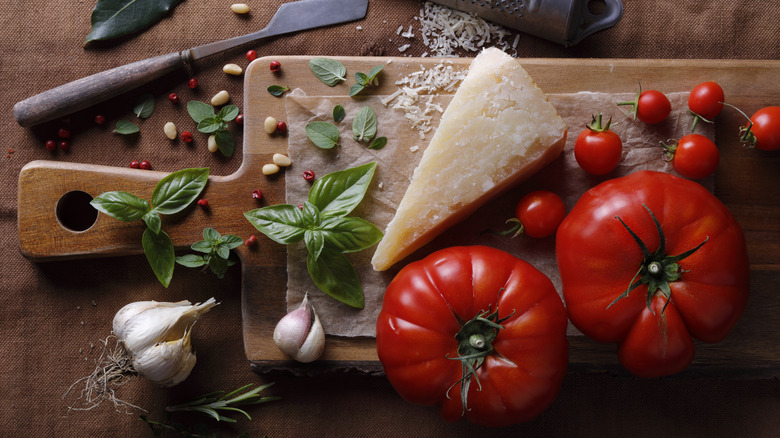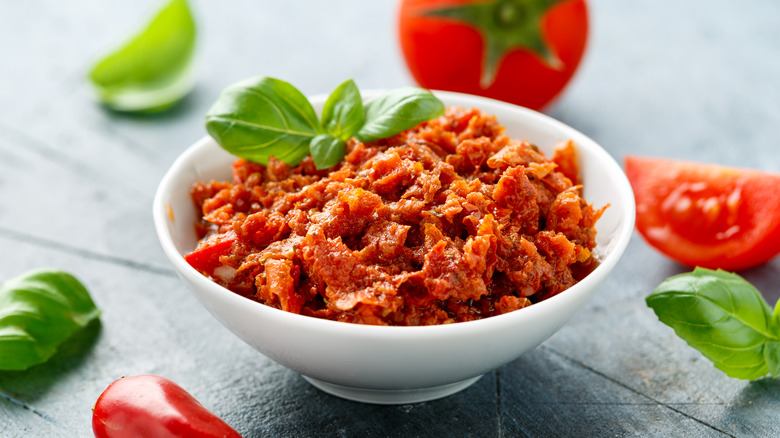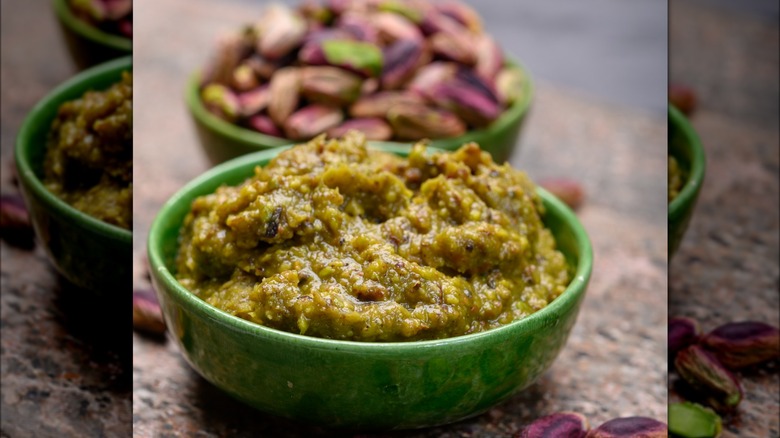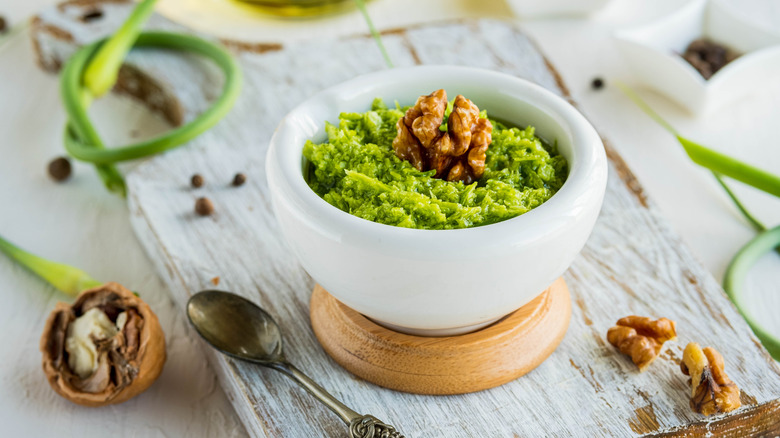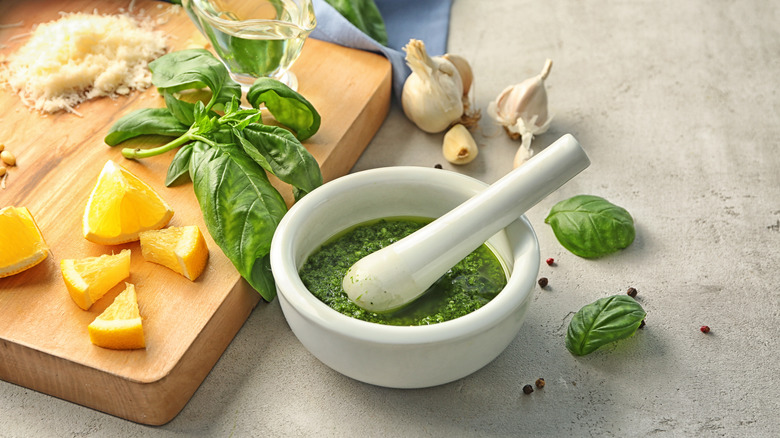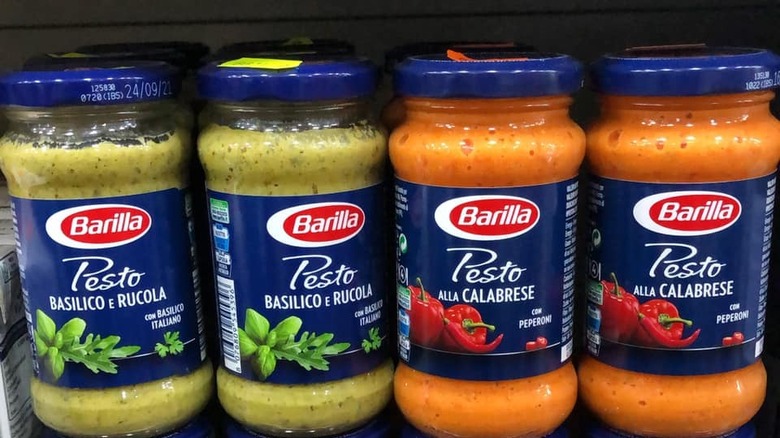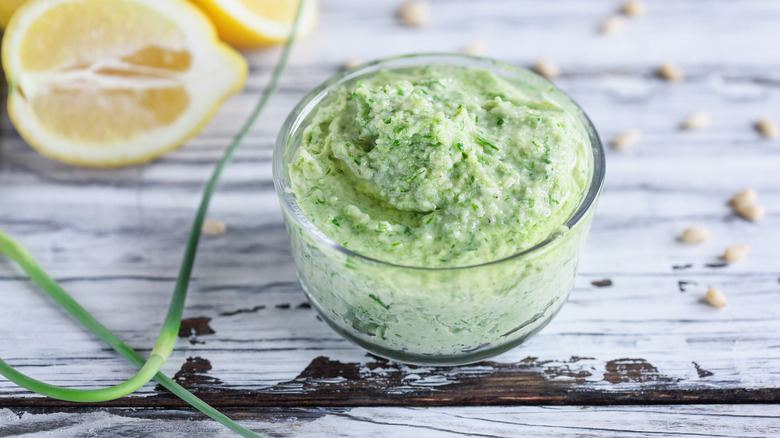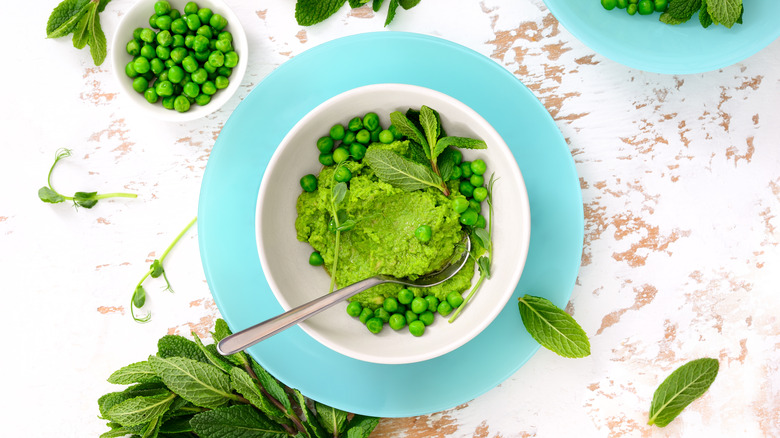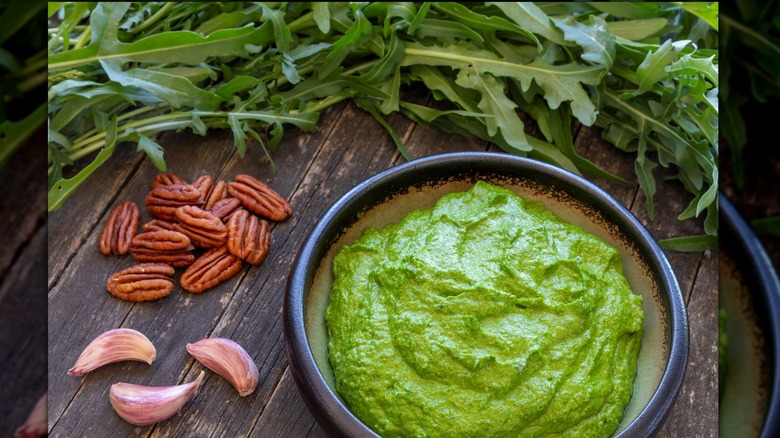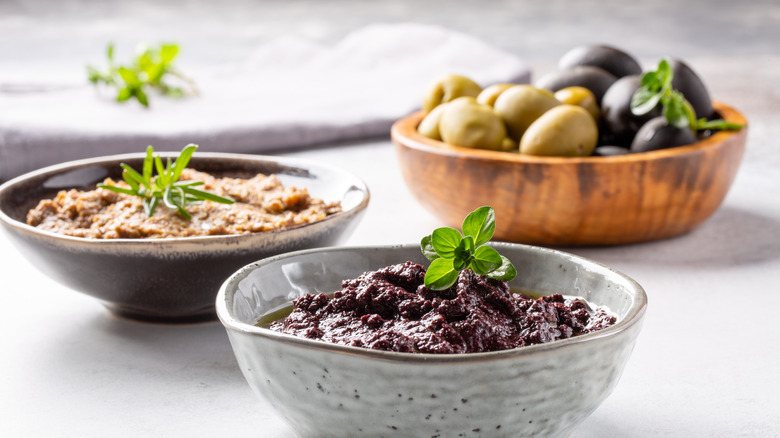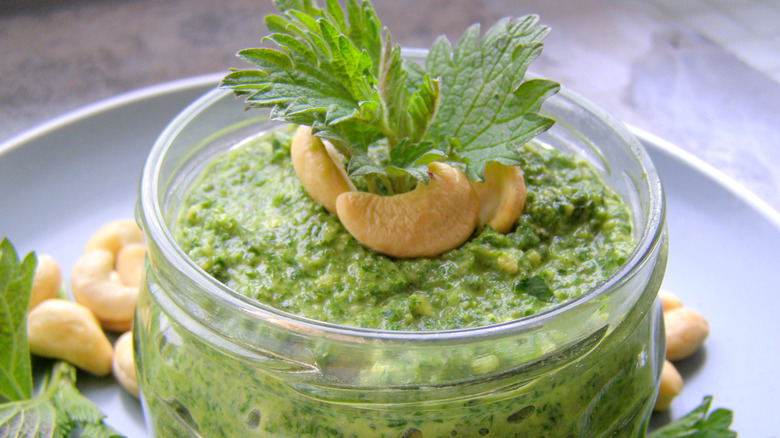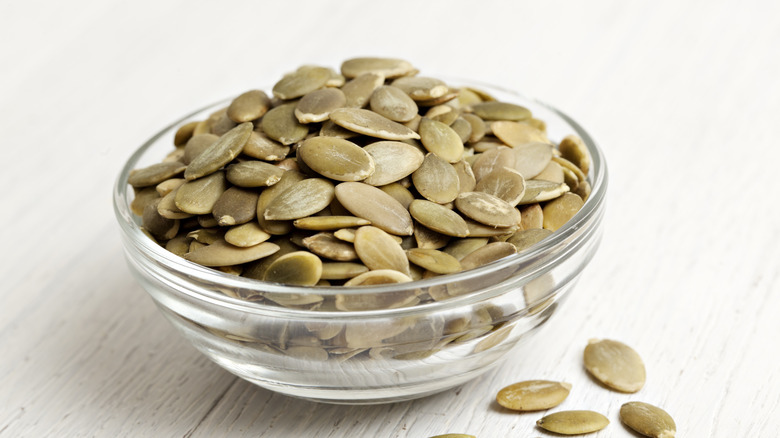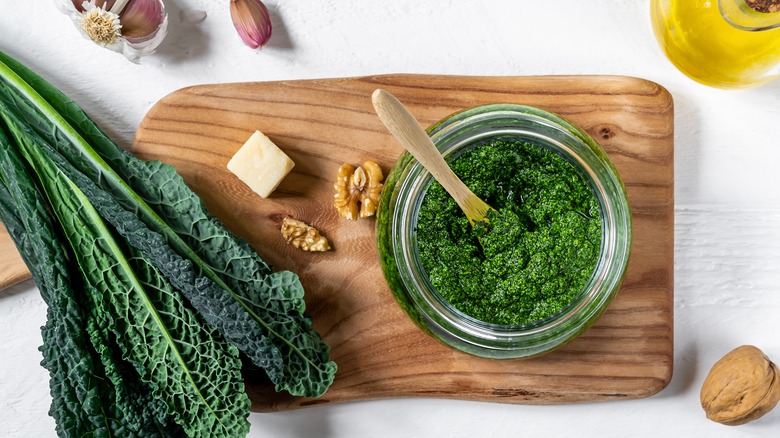15 Types Of Pesto You Should Know About
If you love Italian food, you no doubt have a soft spot for pesto. Whether you call it a sauce, spread, or dip, this savory tradition can be found on pasta and pizzas across the world, from Italy to America. The pesto you most likely know and love is green and made from basil, pine nuts, garlic, and parmesan cheese. But you don't need to limit your pesto profile to just one. There are dozens of ways to make pesto using a variety of nuts, herbs, vegetables, and aromatics.
The name pesto comes from the Italian word meaning to pound. This harkens to its origin as a sauce made in a mortar and pestle by pounding the ingredients to a fine paste. By this definition, anything made by this method can be a pesto. These days, however, many products sold as pestos are made with more modern methods of preparation, like a food processor.
In all pestos, you will find garlic, oil, cheese and herbs — typically basil, but sometimes thyme or rosemary. Many will contain nuts and acids like tomatoes or citrus to balance out the flavor. On the whole, pesto is a herby and salty spread, but the flavor profile changes vastly depending on which ingredients you use. There are well over a dozen types of pesto you've probably never heard of. So, let's dive a little deeper than basil and pine nuts to find some delicious alternatives to regular old pesto.
1. Pesto Genovese
The origin place of pesto is the Liguria region in Northern Italy. Here, you can find some of the freshest basil, pine nuts, and Parmigiano Reggiano in the world. Combine all these ingredients, and you'll find what the region is best known for — its pesto, named pesto Genovese, after the city of Genoa. This is the creation that is now most commonly served as pesto in America.
In addition to basil, parmesan, and pine nuts, garlic, olive oil, salt and pepper are typically used in the making of pesto Genovese. Traditionally, this process would be done by mashing the ingredients in a mortar and pestle, but the spread can also be made in a food processor if you want a faster and easier method. Nobody's nonna is going to knock down your door for taking a shortcut. In keeping with Genovese tradition, parmesan is the cheese you'll find most often used in pestos, although sometimes other cheeses like Pecorino Romano or manchego are used.
2. Pesto alla Trapanese
If you take a step beyond pesto Genovese, you will find a handful of very traditional pestos that have deep roots in the long history of Italian cooking. pesto alla Trapanese, for example, harkens back to the Southern regions of the country. Also known as Sicilian pesto, this sauce is basil-based like its Northern cousin, the Genovese, but it's finished with fresh tomatoes.
Instead of the distinctive pine nuts, pesto Genovese is known for, pesto alla Trapanese traditionally uses almonds. If you use pine nuts or have walnuts on hand, you will still make a distinct pesto from the traditional Genovese, but it won't be a Trapanese. At least, that's what Italians will tell you.
Despite using many of the same ingredients, pesto alla Trapanese has a very distinct flavor from its sister pesto in Genoa. The fresh tomato adds both a bright acidity and a sweetness not normally found in more savory pestos. This one makes an especially excellent sauce for fresh pasta.
3. Pesto Modenese
This whipped spread is perhaps the farthest cry from basil and pine nut-based pestos we're familiar with. Modenese is a white, creamy pesto made with lardo, a type of cured pork that is specific to Italy and is harder to track down outside of the country. Lardo is made from the layer of fatty pork back connected to the rind. It is flavored like salami, although its fat content is much higher, which accounts for its white appearance. By combining the lardo with garlic, Parmigiano Reggiano, and rosemary, you can make this traditional Italian pesto.
Pesto Modenese hails from Modena, located near Bologna in the Northern part of Italy. Unlike many of its cousin pestos from other regions of the country, Modenese is not served as a sauce. Instead, you will usually find it served as a spread or dip alongside breads or crackers. Typically, in its region of origin, it will be served with a tigelle or piadina, both styles of regional Italian flatbreads.
4. Sun dried tomato pesto
This popular form of pesto is also called pesto rosso. Using sun-dried tomatoes instead of fresh ones will massively change the flavor profile of whatever you are making. This is true in the case of pesto, but a traditional pesto rosso takes some other departures from the pesto alla Trapanese as well.
You will not always find basil in pesto rosso. Instead, the herbaceous quality required for the dish can come from rosemary or thyme. Additionally, this pesto doesn't require pine nuts, and typically, a recipe will call for almonds instead. Many recipes call for the additional inclusion of red pepper flakes or roasted red peppers for heat, while other recipes call for herbs like parsley.
You can also simply enhance your regular basil pesto by adding sun-dried tomatoes, which will result in a tremendous and different flavor. Feel free to experiment with the nuts and herbs you use in your recipe in order to find your perfect pesto.
5. Pistachio pesto
There are many types of nuts you can use in pesto instead of pine nuts. Pistachios are just one of them, but they are one of the least expensive alternatives you can find to the pricey pine nut. The fact that pistachios also happen to be extremely full of unique, rich flavor makes this one a bit of a no-brainer.
When it comes to tree nuts, pine nuts nearly top the list of most expensive in the world. They are second only to macadamia nuts. Compared to an average of $23 a pound for pine nuts, pistachios clock in at somewhere between $2 and $2.50 per pound.
Even if you simply replace pine nuts with pistachios in your pesto, you are going to get a much different flavor profile. The two nuts could not be more different. If you really want to experiment, though, you can follow this recipe for arugula and pistachio pesto, which also calls for another healthy, leafy green that we will get to shortly.
6. Walnut pesto
Walnuts are another great alternative to pine nuts that can be swapped into any old pesto recipe. It will certainly yield a different flavor than you're used to, but it will be more environmentally conscious, which might even make it taste better. You might be wondering why this is. What exactly is wrong with pine nuts that we need all these alternatives?
Back in 2015, there was a good deal of reporting on the damage that the demand for pine nuts was doing to the pine ecosystems in Korea and Russia. High demand for pesto was framed as the reason for these unsustainable harvest levels. In the years since, global conditions have not necessarily improved.
Thankfully, there are so many creative pestos you can make using nuts like walnuts and pistachios instead. Combine walnuts with parsley, lemon juice, and a cheese of your choice for a completely unique take on the traditional Italian spread.
7. Pesto Agli Agrumi
Here is another classic Sicilian variation on pesto that takes the same base ingredients and adds even more layers of flavor. Pesto agli agrumi is also known as citrus pesto and takes on a much sweeter flavor profile than your typical pesto Genovese or pesto Modenese.
This recipe starts with the holy trinity of basil, pine nuts, and parmesan. Beyond that, this pesto calls for two types of citrus. With the addition of the juice and zest of oranges and lemons, pesto agli agrumi becomes brighter than its Genovese counterpart. These flavors make it a better fit as a complement to fish and seafood pasta dishes. Sometimes, recipes call for swapping the pine nuts out for almonds, while others might not call for basil. If you have any of these alternate ingredients on hand or want to experiment with a cheaper nut, it's worth trying it both ways to see what you and your guests prefer.
8. Pesto Calabrese
This one is another far cry from the green pesto you know and love on your pasta. Pesto Calabrese is made with roasted red peppers and tomatoes, and the sauce takes on the main ingredients' color and flavor. The rest of the recipe is where the real diversions from the Ligurian tradition begin. Traditionally, a pesto Calabrese is ricotta, olive oil, and almonds in addition to the peppers and tomatoes.
Actually inspired by the Genovese, Italians in Calabria put their own spin on pesto with this sweet and spicy condiment. The different climates of this part of the country led to different ingredients becoming popular, hence the use of regional favorites peppers and ricotta cheese. If you're making this spicy pesto and want an extra kick of the authentic, you can use Calabrian chilis. You can find them roasted in a can or buy them fresh to roast yourself; just make sure they are roasted since that charred flavor is such a crucial part of this recipe.
9. Garlic scape pesto
If you have a garden or buy your garlic in full bulbs, you might be familiar with garlic scapes. Otherwise, we wouldn't be surprised if you've never heard of them before. These edible parts of the garlic plant are the shoots that extend from the bulb, and they can actually be quite tasty when cooked in the right way or combined with the right ingredients.
The garlic flavor you get from a scape isn't as intense as a garlic clove, and it's more floral as well. If you're using it in a pesto recipe, you can even swap it in for the basil. This way, you can get two ingredients in there for the price of one since you don't need to add a clove to the mixture. You'll get plenty of garlic flavor from the scapes. The pesto will also keep its signature green color by using these green stalks in conjunction with pine nuts, parmesan, olive oil and seasoning. If you want a bit more brightness, you can use half and half garlic scapes and basil and get a great result from that combination as well.
10. Mint pesto
Another interesting route to go with your pesto is looking at what other flavors compliment the ingredients you are already using. For example, mint and basil are flavors that are as classic a duo as peanut butter and chocolate. Ok, maybe not quite, but mint adds quite the dimension to your pesto that you might not have thought about. Don't worry; it won't make your tortellini taste like toothpaste.
Basil and mint are a great flavor combination when balanced correctly. Mint also opens up a wide range of possibilities when pairing your pesto with other dishes. It no longer needs to be relegated just to pasta and appetizers. Mint is classically paired with lamb in the form of jelly, or more contemporarily, a chimichurri. If you indulge in lamb, next time you are cooking a kebab or a chop, consider pairing it with a homemade mint and basil pesto.
11. Arugula pesto
Instead of using basil or a similar herb as the base of your pesto, you can try using a flavorful green instead. Arugula is one of the more popular options for a couple of reasons. For one, even raw arugula is a very flavorful leafy green. It has a natural peppery taste that makes it a natural fit for a pesto. Eating it also comes linked to a bunch of health benefits, including reduced risk of cancer, diabetes, and osteoporosis, according to Medical News Today.
You can add arugula to your regular pesto recipe or try something new entirely by adding other ingredients like ricotta. This pesto recipe with basil, arugula, ricotta and parmesan cheeses is an enhanced take on the classic that amps up both the salt and pepper levels to maximize flavor. You can also try combining the peppery arugula with a sweeter nut, like a pecan or a pistachio. This will help create a more balanced flavor if you want the benefits of the healthy green but not its intense flavor.
12. Olive pesto
You might argue and say you might as well call this an olive tapenade, but Italian retail brands disagree and even sell the stuff by jars in the store. Regardless of what you call it, if you make it with enough of the same ingredients as pesto, you can pass your dip, spread, or sauce off as a refined elevation of an Italian favorite.
The type of olive you use can make a huge difference in the type of olive pesto you create. A more tapenade-like dip will typically use black olives or kalamata olives, oftentimes a mix of the two. Which olives you use and how much of them will influence the color of your pesto, and more often than not this variety will turn out light or dark brown. However, by making a pesto with green olives, parsley, and basil, for example, you can still achieve both the bright green color of a traditional pesto and the briny taste of olives.
13. Cashew pesto
Pesto is delicious as a hors d'oeuvre or as a sauce served over pasta. Unfortunately, due to the inclusion of parmesan in most pestos, vegans are mostly prohibited from getting to indulge in this sauce when they go out. As a response, we've started to see more ideas for how to make pesto more vegan-friendly and thus far, most of them involve cashews.
The cashew is already a popular ingredient for making vegan alternatives to cheese. When ground and mixed with nutritional yeast and non-dairy milk of choice, cashews can become silky and give off a texture extremely similar to cheese; likewise, it's easy to use cashews instead of cheese in your pesto recipe and still yield the paste-like texture desired from the sauce.
Using cashews as a substitute is environmentally conscious as well, even if you don't use them to replace the unsustainable pine nuts. Dairy farms are a significant source of greenhouse gas emissions, so even if you are not going vegan this year or any, consider using cashews instead of cheese from time to time.
14. Pumpkin seed pesto
While you can certainly scour the shelves of Whole Foods looking for substitutes for pine nuts in your pesto, the best might be in your house already, just waiting to be extracted from that Halloween pumpkin. That's right; pumpkin seeds are an excellent ingredient for pesto since they share a sweet and strongly nutty aroma and flavor. Although, you actually don't have to use your own pumpkin seeds if you don't have to. It might be better if you don't, in fact.
Instead, this recipe is more commonly made using pepitas, which are an unshelled variety of pumpkin seeds. These small, green-ish seeds are only found in specific pumpkin varieties, which are considered hulless due to the seeds' lack of a shell. While the flavor of pepitas is similar to other pumpkin seeds, when it comes to breaking them down into a fine paste, these smaller seeds make a smoother paste. Along with the myriad health benefits of all types of pumpkin seeds, according to a medically reviewed article on WebMD, this textural makes pepitas an excellent choice for pesto.
15. Kale Pesto
Making this pesto is a delicious way to add a healthy green superfood to your meal. That's right, categorically, kale is a superfood and eating it will give you many nutritional benefits, including a boost in vitamins and fiber. Kale can taste great, but it has a reputation for being bitter and unappealing, which it also can be. Incorporating the bitter green into your pesto is one of the many ways you can make it more palatable for yourself, friends, or family.
The easiest kale pesto recipe is to swap out the large chunks of basil for kale leaves. However, other ingredients might be needed to compliment the kale and bring the flavor more in line with what you might expect from a typical pesto. Lemon is a great way to brighten up your kale pesto and should be considered essential in this variation. If you're looking for a nuttier flavor, the addition of seeds like pepitas or hemp seeds can help bring that to this kale-based spread.
